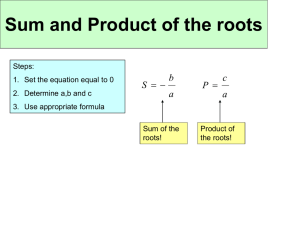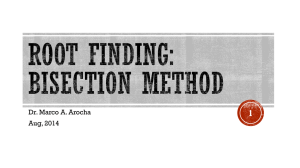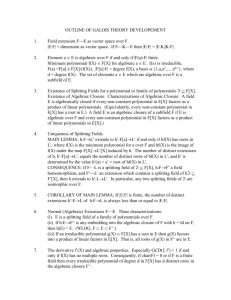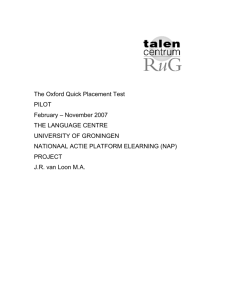SOLVING THE CUBIC
advertisement
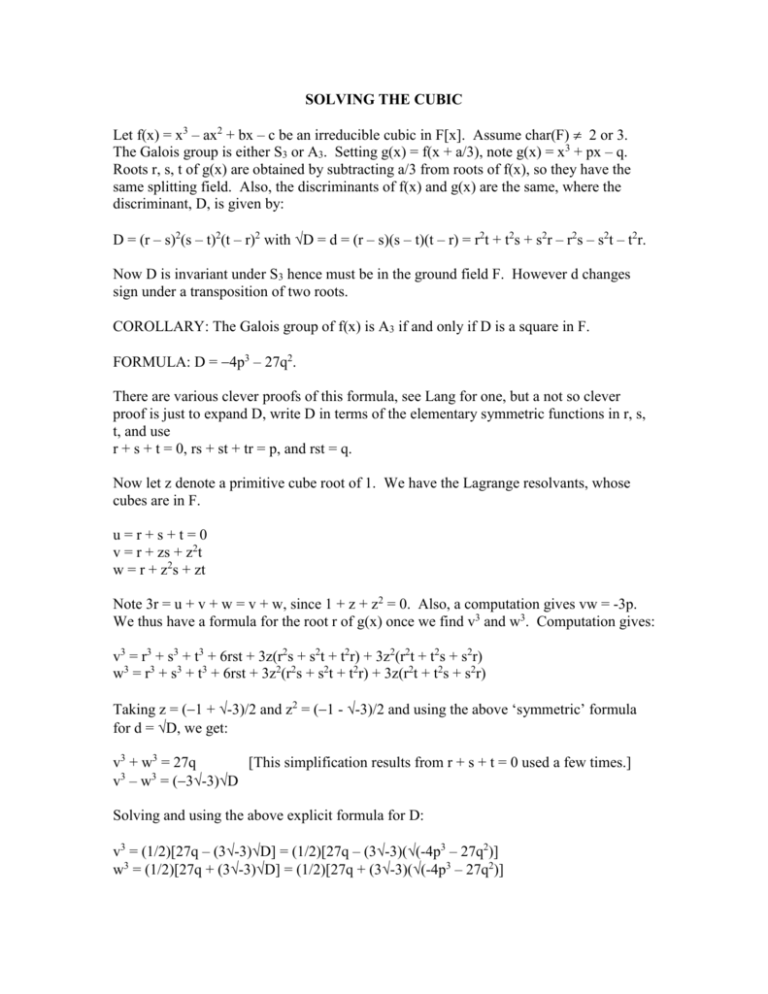
SOLVING THE CUBIC
Let f(x) = x3 – ax2 + bx – c be an irreducible cubic in F[x]. Assume char(F) 2 or 3.
The Galois group is either S3 or A3. Setting g(x) = f(x + a/3), note g(x) = x3 + px – q.
Roots r, s, t of g(x) are obtained by subtracting a/3 from roots of f(x), so they have the
same splitting field. Also, the discriminants of f(x) and g(x) are the same, where the
discriminant, D, is given by:
D = (r – s)2(s – t)2(t – r)2 with D = d = (r – s)(s – t)(t – r) = r2t + t2s + s2r – r2s – s2t – t2r.
Now D is invariant under S3 hence must be in the ground field F. However d changes
sign under a transposition of two roots.
COROLLARY: The Galois group of f(x) is A3 if and only if D is a square in F.
FORMULA: D = 4p3 – 27q2.
There are various clever proofs of this formula, see Lang for one, but a not so clever
proof is just to expand D, write D in terms of the elementary symmetric functions in r, s,
t, and use
r + s + t = 0, rs + st + tr = p, and rst = q.
Now let z denote a primitive cube root of 1. We have the Lagrange resolvants, whose
cubes are in F.
u=r+s+t=0
v = r + zs + z2t
w = r + z2s + zt
Note 3r = u + v + w = v + w, since 1 + z + z2 = 0. Also, a computation gives vw = -3p.
We thus have a formula for the root r of g(x) once we find v3 and w3. Computation gives:
v3 = r3 + s3 + t3 + 6rst + 3z(r2s + s2t + t2r) + 3z2(r2t + t2s + s2r)
w3 = r3 + s3 + t3 + 6rst + 3z2(r2s + s2t + t2r) + 3z(r2t + t2s + s2r)
Taking z = (1 + -3)/2 and z2 = (1 - -3)/2 and using the above ‘symmetric’ formula
for d = D, we get:
v3 + w3 = 27q
[This simplification results from r + s + t = 0 used a few times.]
3
3
v – w = (3-3)D
Solving and using the above explicit formula for D:
v3 = (1/2)[27q – (3-3)D] = (1/2)[27q – (3-3)((-4p3 – 27q2)]
w3 = (1/2)[27q + (3-3)D] = (1/2)[27q + (3-3)((-4p3 – 27q2)]
r = v + w gives a formula for one root of g(x) as a sum of two cube roots of elements of
F[D]. This is Cardan’s formula, as derived by Lagrange. The cube roots v and w are
not independent since vw = 3p. One gets the other two conjugates s and t of r by
reinterpreting the cube roots v, w, keeping the product vw = –3p:
r=v+w
s = zv + z2w
t = z2v + zw.
Solving the quartic is harder. The composition series for S4 is S4 > A4 > V4 > C2 > 1.
The Galois group is reduced to A4 by adjoining the square root of the discriminant, which
is not a pretty sight for a quartic. If the four roots are r, s, t, u then the element rs + tu is
invariant under V4 = {1, (rs)(tu), (rt)(su), (ru)(st)}. Its conjugates under A4 are rs + tu,
rt + su, and ru + st. These three elements are roots of a cubic over F[D], which can be
computed explicitly and solved with the Cardan formulas. This gives the fixed field of
V4. If C2 = {1, (rs)(tu)} then elements rs and r + s are in the fixed field of C2. Their V4
conjugates are tu and t + u, respectively, and one can find all these elements by solving
quadratic equations over the fixed field of V4. This gives the fixed field of C2. Finally,
one finds r, s, t, u by solving quadratic equations over the fixed field of C2. There are
some books that carry all this out explicitly.





